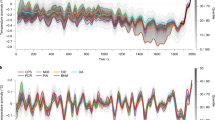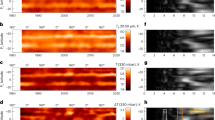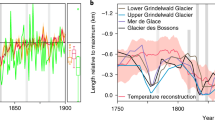Abstract
Triton, Neptune's largest moon, has been predicted to undergo significant seasonal changes that would reveal themselves as changes in its mean frost temperature1,2,3. But whether this temperature should at the present time be increasing, decreasing or constant depends on a number of parameters (such as the thermal properties of the surface, and frost migration patterns) that are unknown. Here we report observations of a recent stellar occultation by Triton which, when combined with earlier results, show that Triton has undergone a period of global warming since 1989. Our most conservative estimates of the rate of temperature and surface-pressure increase during this period imply that the atmosphere is doubling in bulk every 10 years—significantly faster than predicted by any published frost model for Triton2,3. Our result suggests that permanent polar caps on Triton play a dominant role in regulating seasonal atmospheric changes. Similar processes should also be active on Pluto.
This is a preview of subscription content, access via your institution
Access options
Subscribe to this journal
Receive 51 print issues and online access
$199.00 per year
only $3.90 per issue
Buy this article
- Purchase on Springer Link
- Instant access to full article PDF
Prices may be subject to local taxes which are calculated during checkout


Similar content being viewed by others
References
Spencer, J. R. Nitrogen frost migration on Triton: a historical model. Geophys. Res. Lett. 17, 1769–1772 (1990).
Hansen, C. J. & Paige, D. A. Athermal model for the seasonal nitrogen cycle on Triton. Icarus 99, 273–288 (1992).
Spencer, J. R. & Moore, J. M. The influence of thermal inertia on temperatures and frost stability on Triton. Icarus 99, 261–272 (1992).
McDonald, S. W. & Elliot, J. L. Triton stellar occultation candidates: 1995–1999. Astron. J. 109, 1352–1362 (1995).
Holfeltz, S. T. FGS Instrument Handbook(Space Telescope Science Institute, Baltimore, 1996).
Elliot, J. L. et al. Occultation of ε Geminorum by Mars. II. The structure and extinction of the Martian upper atmosphere. Astrophys. J. 217, 661–679 (1977).
Elliot, J. L., Stansberry, J. A., Olkin, C. B., Agner, M. A. & Davies, M. E. Triton's distorted atmosphere. Science 278, 436–439 (1997).
8. Elliot, J. L. & Young, L. A. Analysis of stellar occultation data for planetary atmospheres. I. Model fitting, with application to Pluto. Astron. J. 103, 991–1015 (1992).
Olkin, C. B. et al. The structure of Triton's atmosphere: Results from the entire ground-based occultation data set. Icarus 129, 178–201 (1997).
Tyler, G. L. et al. Voyager radio science observations of Neptune and Triton. Science 246, 1466–1473 (1989).
Gurrola, E. M. Interpretation of Radar Data from the Icy Galilean Satellites and TritonThesis, Stanford Univ. (1995).
Strobel, D. F., Zhu, X., Summers, M. E. & Stevens, M. H. On the vertical thermal structure of Pluto's atmosphere. Icarus 120, 266–289 (1996).
Krasnopolsky, V. A., Sandel, B. R., Herbert, F. & Vervack, R. J. Temperature, N2, and N density profiles of Triton's atmosphere: observations and model. J. Geophys. Res. 98, 3065–3078 (1993).
Davies, M. E., Rogers, P. G. & Colvin, R. R. Acontrol network of Triton. J. Geophys. Res. 96, 15675–15681 (1991).
Marouf, E. A., Tyler, G. L., Eshleman, V. R. & Rosen, P. A. Voyager radio occultation of Triton: surface topography and radius. Bull. Am. Astron. Soc. 23, 1207 (1991).
Trafton, L. Large seasonal variations on Triton. Icarus 58, 312–324 (1984).
Ingersoll, A. P. Dynamics of Triton's atmosphere. Nature 344, 315–317 (1990).
Smith, B. A. et al. Voyager 2 at Neptune: Imaging science results. Science 246, 1422–1449 (1989).
Buratti, B. J., Goguen, J. D., Gibson, J. & Mosher, J. Historical photometric evidence for volatile migration on Triton. Icarus 110, 303–314 (1994).
Eluszkiewicz, J. On the microphysical state of the surface of Triton. J. Geophys. Res. 96, 19217–19230 (1991).
Duxbury, N. S. & Brown, R. H. The phase composition of Triton's polar caps. Science 261, 748–751 (1993).
Acknowledgements
We thank E. Nelan and B. McArthur for help in reducing our data; the IRTF staff, the staff of the Lear Jet Observatory at NASA Ames, F. Osell, M. Kakkala, J. Kern, R. Meserole, C. Dahn and R. Stone for assistance; and D. Strobel for discussions. This work was supported, in part, by NASA, NSF, and the National Geographic Society. The NASA/ESA Hubble Space Telescope observations were supported by STScI, which is operated by Association of Universities for Research in Astronomy, Incorporated.
Author information
Authors and Affiliations
Rights and permissions
About this article
Cite this article
Elliot, J., Hammel, H., Wasserman, L. et al. Global warming on Triton. Nature 393, 765–767 (1998). https://doi.org/10.1038/31651
Received:
Accepted:
Issue Date:
DOI: https://doi.org/10.1038/31651
This article is cited by
-
Possible explosion crater origin of small lake basins with raised rims on Titan
Nature Geoscience (2019)
-
Instrumental methods for professional and amateur collaborations in planetary astronomy
Experimental Astronomy (2014)
-
Atmospheric Electrification in the Solar System
Surveys in Geophysics (2006)
Comments
By submitting a comment you agree to abide by our Terms and Community Guidelines. If you find something abusive or that does not comply with our terms or guidelines please flag it as inappropriate.



